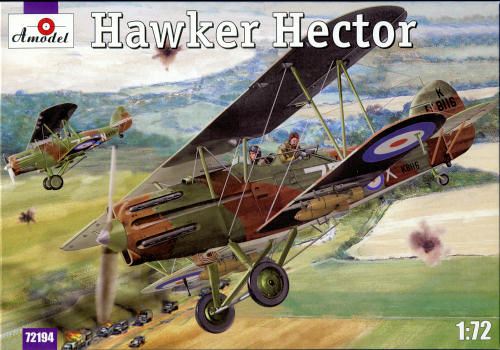
Amodel 1/72 Hawker Hector
| KIT #: | 72194 |
| PRICE: | $18.95 from www.scale-model-kits.com |
| DECALS: | One option |
| REVIEWER: | Scott Van Aken |
| NOTES: |

| HISTORY |
The Hawker Hector was intended as a replacement for the Hawker Audax Army co-operation aircraft. Because of the demand for Rolls-Royce Kestrel engines required for the Hawker Hind program, an alternative power plant was specified. Consequently the Napier Dagger III was used.
Although both the design and the building of the prototype was done by Hawkers, the subsequent production aircraft were built by Westland Aircraft in Yeovil, Somerset. The prototype first flew on on 14 February 1936 with George Bulman as pilot. One prototype and 178 production aircraft were built. 13 of these were supplied to Eire in 1941-2.
The Hector equipped seven RAF army co-operation squadrons, but began to be replaced by Westland Lysanders in 1938. The Hectors were transferred to Auxiliary Air Force squadrons; 613 Squadron used theirs to attack German troops advancing through northern France in May 1940. Two aircraft were lost in combat over Calais, before the squadron was evacuated. Hectors were used by the RAF from 1940 as target-towers, and for towing the General Aircraft Hotspur training glider.
Irish Air Corps examples were received after the Dunkirk Evacuation. In general they were in poor condition. They were sold by the British War Office to the Irish Free State upon requests for aircraft. The Irish military were wholly unprepared for major warfare, but still relied almost totally on military supplies from Britain. The defense of Ireland was also in the British interest, but with the Battle of Britain raging in the skies, could afford to sell the Irish Government nothing better than the Hector. The type was deeply unpopular with ground crews due to the extremely complicated nature of the engine, which had 24 cylinders, and therefore 48 spark plugs and 96 valves, all of which required frequent maintenance.
| THE KIT |
 A-Model's Hector is the second one I know of that has been produced in injected plastic, the other being an Aeroclub production that was considerably less parts intensive than is this one. Amodel has been improving each kit they make, but a wise modeler will treat each as a short run kit and do lots of test fitting prior to applying cement.
A-Model's Hector is the second one I know of that has been produced in injected plastic, the other being an Aeroclub production that was considerably less parts intensive than is this one. Amodel has been improving each kit they make, but a wise modeler will treat each as a short run kit and do lots of test fitting prior to applying cement.
This kit has very nicely done surface and interior detailing with various boxes and bracing shown on the inside of the fuselage halves. According to the parts layout, there are a considerable number of bits not used on this boxing which intimates other Hector versions, probably an Irish Air Corps one. The kit uses, I believe, low pressure molding so the detailing isn't as crisp as on some more mainstream kits. I noticed a few sink areas on the fuselage, thanks to the details on the inside that make those parts thicker than the rest. The cockpit is quite nicely done with a period looking floor on which the rudder pedals, control stick and seat are placed. For the rear gunner there is a small seat and his Lewis gun and mount.
The wings are butt fit and a single piece with little nubs on the underside for the unused light bombs. What is provided is a pair of mounts for a large bomb under each wing or one can install some sort of pannier that may carry small anti-personnel bomblets or perhaps supplies. Other things of note are separate tires and wheels which definitely improves the problem of painting them. The struts are, for the most part, single items that fit into holes in the wing and fuselage. The outboard N struts are a single molding. It would be in the modeler's interest to enlarge these attachment holes as they are quite small. 
Instructions are well done with nicely drawn construction steps. Color references are with Humbrol paints and generic name. There is no rigging diagram, but one can easily glean that information from the box art. Only one markings option is provided and that is for 613 squadron in May of 1940 during the Dunkirk operation as shown on the box top. The decals are nicely printed and should work just fine with setting solutions. I find it interesting that this has a white underside with the left wing underside in black on both the top and bottom wing.
| CONCLUSIONS |
Nice to see this aircraft generally available. It is not one for the beginner, but if you have some experience with short run kits, then this one should prove to be no problem. The result will be an interesting aircraft and one that will look great in your biplane collection. Thanks to the sprues layout, I can foresee a number of similar Hawker types being released over the years.
| REFERENCES |
http://en.wikipedia.org/wiki/Hawker_Hector
Thanks to www.scale-model-kits.com for the preview kit. Get yours from the link and at a savings.
December 2009
If you would like your product reviewed fairly and fairly quickly, please contact the editor or see other details in the